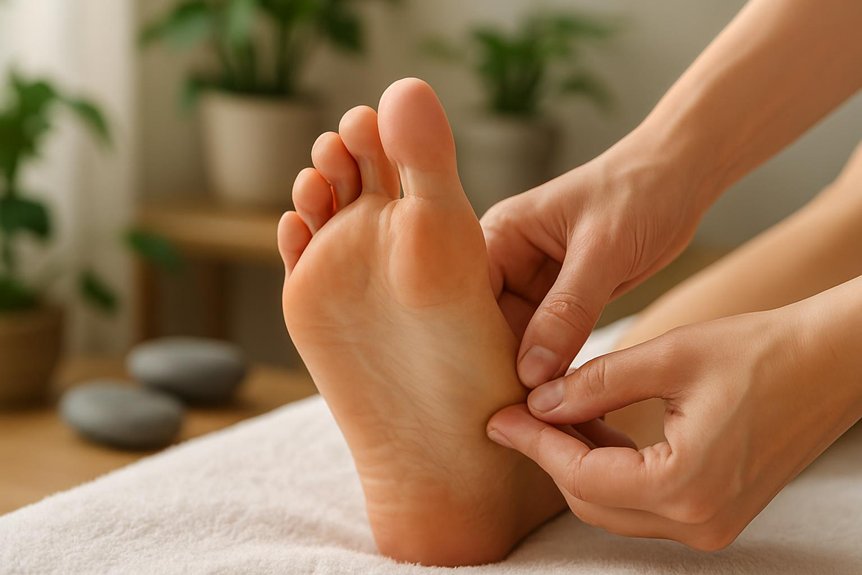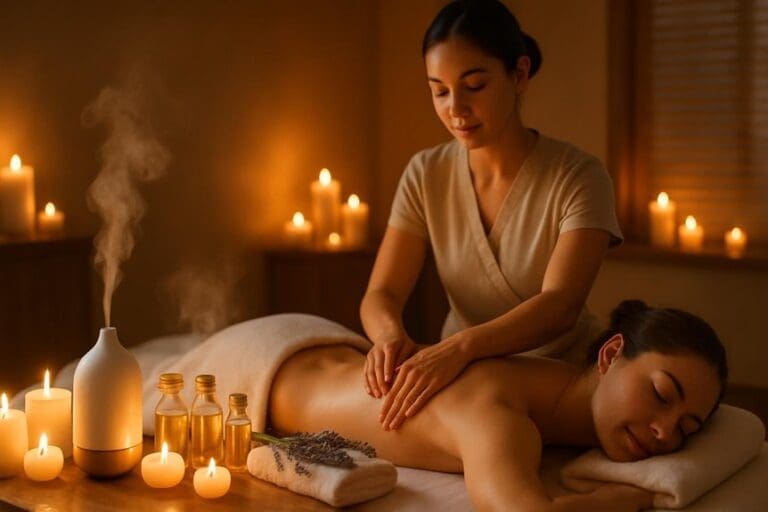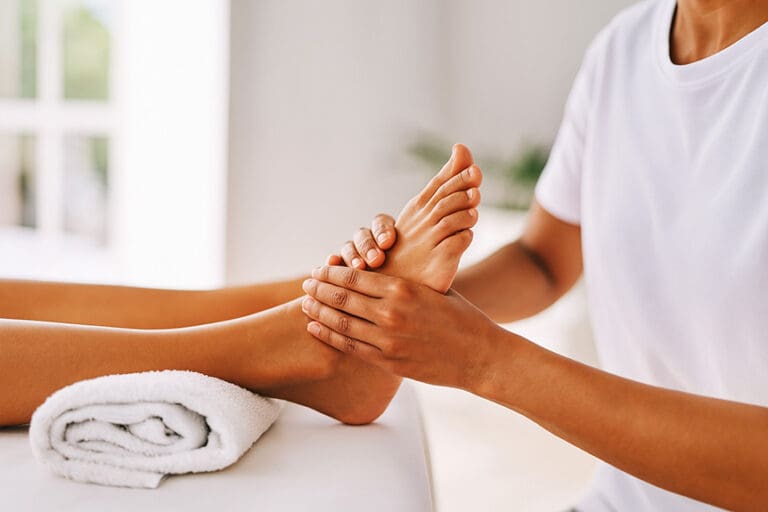It does not realign a bunion deformity, but it may reduce pain and stiffness. Targeted pressure to hallux and medial arch reflex zones can modulate nociception (A‑beta gating), ease myofascial tension, and improve microcirculation, supporting parasympathetic balance. Techniques are gentle, graded, and avoid direct pressure during flare-ups. It is appropriate for mild-to-moderate cases without acute inflammation or lesions, and complements footwear modification and exercises. Contraindications apply. Evidence suggests symptomatic relief; further details explain mechanisms, techniques, and safety.
Understanding Bunions: Causes, Symptoms, and Progression
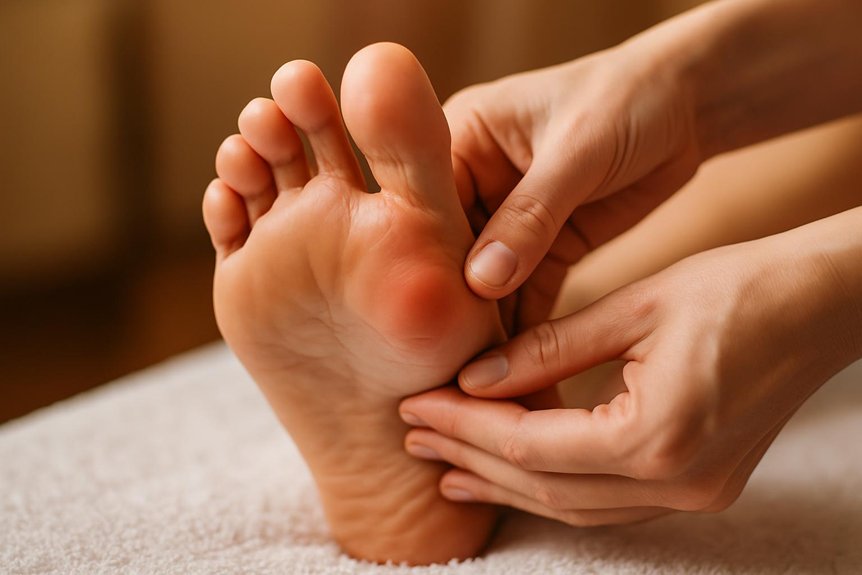
Why do bunions develop, and how do they progress over time? A bunion (hallux valgus) reflects lateral deviation of the great toe with medial deviation of the first metatarsal, driven by biomechanical imbalance and genetic predisposition. Contributing factors include pes planus, hypermobility, tight gastrocnemius–soleus complex, ligamentous laxity, and ill-fitting footwear that narrows the forefoot.
Progressive subluxation of the first metatarsophalangeal joint alters load distribution, provoking capsular attenuation, sesamoid displacement, and osteoarthritic change.
Symptoms begin with local tenderness, erythema, and shoe irritation, advancing to aching after activity, reduced first-ray dorsiflexion, callus under the second metatarsal head, and occasional neuritic pain.
In advanced stages, deformity stiffens, gait efficiency declines, and balance may suffer.
At Spa & Massage, therapists observe these patterns during intake, tailoring gentle soft-tissue work to ease periarticular tension, support comfort, and complement podiatric care. Some clients find additional relief by incorporating aromatherapy massage techniques, which can help relax muscles and enhance the soothing effects on foot discomfort.
What Reflexology Is and How It Works on the Feet
It is a manual therapy that applies calibrated pressure to specific foot reflex zones mapped to musculoskeletal and autonomic functions.
Using controlled pressure-point techniques, therapists aim to modulate local tissue tone, circulation, and nociceptive signaling.
Evidence suggests these inputs may influence the nervous system response—shifting autonomic balance and reducing perceived pain—an approach our Spa & Massage clinicians apply with careful pressure dosing and patient feedback.
Foot Reflex Zones
Curiously, the feet contain discrete reflex zones mapped to musculoskeletal, neural, and visceral structures throughout the body, forming the basis of foot pressure therapy. Standard charts position head and cervical regions along the toes, thoracic and upper limb representations across the distal metatarsals, and pelvic–lumbar associations toward the heel and medial arch.
The medial hallux and first metatarsal correlate with cervical–cranial pathways; the lateral foot relates to shoulder–hip girdles.
From Spa & Massage’s clinical perspective, these zones guide assessment and session planning. Therapists note tissue texture, tenderness, and temperature variance across mapped areas to infer autonomic tone and regional stress.
While it does not replace medical care, zone-oriented work can modulate perceived pain, improve local circulation, and promote parasympathetic balance—supporting comfort for clients managing bunion-related strain.
Pressure-Point Techniques
Building on the mapped foot reflex zones, pressure-point techniques apply graded, site-specific mechanical stimuli to these areas to influence nociceptive input, autonomic tone, and perceived musculoskeletal tension. Practitioners use thumb-walking, sustained ischaemic compression, and micro-mobilisation along metatarsal heads, medial arch, and ankle retinacula.
Pressure is titrated to patient tolerance, typically 2–6/10 on a discomfort scale, held 8–20 seconds, then released to permit reperfusion. For bunion-related discomfort, attention often centres on the hallux reflex area, adductor hallucis insertions, and plantar fascia attachments.
At Spa & Massage, clinicians integrate lubricant-sparing contact for precision, progressing from superficial warming to deeper, perpendicular loading. They monitor tissue yield, skin blanching, and client breathing to calibrate intensity, aiming to modulate pain gating, reduce myofascial guarding, and restore supple foot mechanics without provoking inflammatory flare.
Nervous System Response
A neurophysiological model frames foot pressure therapy as targeted cutaneous–mechanoreceptor stimulation that modulates afferent signaling to the spinal cord and brainstem, influencing pain gating, autonomic balance, and perceived tension.
In practice, gentle–to–firm pressure over metatarsal heads and medial arch recruits A‑beta fibers, which can inhibit nociceptive transmission via dorsal horn interneurons (gate‑control).
Concurrently, slow, sustained strokes enhance parasympathetic tone—lowering sympathetic arousal, softening muscle guarding around the first metatarsophalangeal joint, and easing protective splinting.
Spa & Massage therapists apply graded, pain‑free inputs, monitoring respiration and tissue reactivity to optimize vagal engagement.
While bunion morphology is structural, this neuromodulatory approach can reduce hyperalgesia and improve foot comfort, allowing gentler loading and better shoe tolerance.
Clients often report warmth, calmer breath, and a steadier, less defensive stance.
Can It Reduce Bunion Pain and Discomfort?
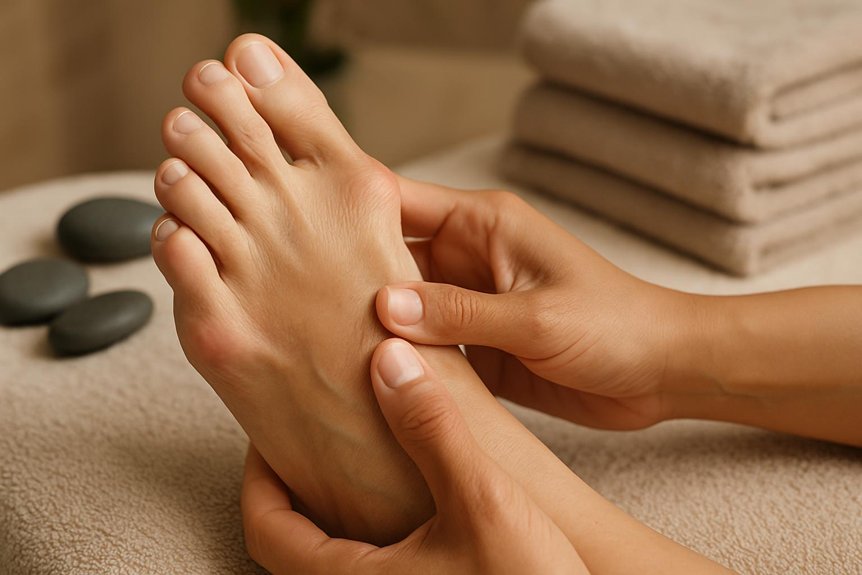
Evidence suggests it may attenuate bunion-related pain via modulation of local nociception, improved microcirculation, and reduction of myofascial tension surrounding the first metatarsophalangeal joint.
Practitioners at Spa & Massage focus on targeted foot zones—particularly the hallux, medial arch, ankle, and corresponding spinal reflex areas—to address compensatory strain patterns.
During symptomatic flare-ups, techniques are adjusted to low-pressure, non-provocative protocols with careful avoidance of inflamed prominences to maintain safety and minimise exacerbation.
How It Helps
While it cannot correct the structural deformity of a bunion (hallux valgus), it may reduce associated pain and discomfort through neuromodulation, circulatory enhancement, and muscle-tendon relaxation.
Mechanistically, gentle, graded pressure along the foot modulates cutaneous and deep mechanoreceptors, downregulating nociceptive signaling via spinal gating and central inhibition. Improved microcirculation may diminish periarticular congestion, easing throbbing and warmth.
Reflex-induced relaxation of intrinsic foot muscles and the flexor hallucis complex can lower aberrant tension around the first metatarsophalangeal joint, reducing protective guarding.
In Spa & Massage clinics, therapists apply calibrated pressures and slow holds to promote parasympathetic dominance, attenuate sympathetic overdrive, and support tissue recovery.
Clients often report softer, steadier foot loading post-session, with less end-of-day ache. It complements footwear modification and clinician-led care.
Targeted Foot Zones
Building on these mechanisms, targeted reflex zones are selected to modulate nociception around the first metatarsophalangeal (MTP) joint and adjacent soft tissues.
Practitioners at Spa & Massage map pressure to the hallux reflex area, medial longitudinal arch, and ankle-retinacular points to influence perceived pain, local edema, and protective muscle guarding.
Gentle, graded compression along the hallux base and sesamoid corridor aims to downregulate peripheral sensitisation, while slow circular friction over the medial arch supports venous and lymphatic return.
Sessions prioritise low-load, sustained holds (20–40 seconds) with careful dose–response monitoring to prevent irritability.
Clients commonly report softer tissue tone and easier toe-off in gait immediately post-session.
Therapists complement this with diaphragmatic-breath pacing to stabilise autonomic arousal, supporting a calmer pain experience and more comfortable foot mechanics between appointments.
Managing Flare-Ups Safely
During symptomatic flare-ups of hallux valgus, zone therapy can be applied as an adjunct to standard self-care to attenuate pain and swelling without provoking irritability. Evidence suggests gentle, short-duration sessions modulate nociception and autonomic tone.
At Spa & Massage, therapists prioritise non-provocative techniques: light-pressured effleurage to the plantar and medial forefoot, brief holds on relevant reflex zones, and avoidance of direct compression over the inflamed bunion. Sessions are capped at 10–15 minutes per foot during acute inflammation.
Cold therapy, footwear offloading, and NSAID guidance from a GP remain primary measures; it complements rather than replaces them. Clients are advised to monitor pain scores and erythema; increased warmth or throbbing warrants cessation.
Post-session, our therapists recommend limb elevation, neutral joint positioning, and gentle calf-pump mobilisations to support venous return and reduce edema.
Zone Therapy Techniques Our Therapists Use Around the Bunion Area
Although bunions are structural deformities best managed medically, Spa & Massage therapists apply targeted pressure point protocols to modulate nociception, reduce periarticular soft‑tissue tension, and support foot biomechanics.
Around the first metatarsophalangeal joint, they use graded pressure gliding proximal to distal to decompress dorsal fascia, followed by slow circular frictions along the adductor hallucis and flexor hallucis brevis bellies.
Thumb‑walking with submaximal load is applied medial to the eminence, avoiding bony irritation, to influence local mechanoreceptors and promote lymphatic clearance.
They integrate myofascial unwinding of the medial longitudinal arch, mobilize first ray plantar tissues with gentle shear, and perform interphalangeal traction for neuromodulatory effect.
Reflex mapping targets spinal, hip, and pelvic zones to recalibrate gait patterns.
Sequencing ends with diaphragmatic breathing cues and passive toe abduction to reinforce elongation.
Safety Considerations: When It Is Appropriate for Bunions
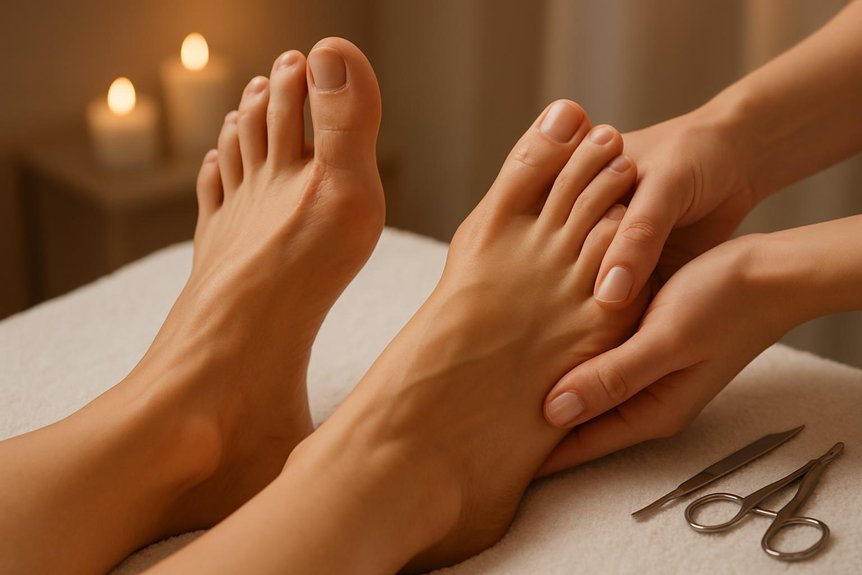
When considering this therapy for bunions, Spa & Massage clinicians prioritise clinical screening to determine suitability, minimise risk, and align expectations. Appropriateness hinges on tissue status, pain thresholds, and comorbidities.
It is generally safe for mild-to-moderate hallux valgus without acute inflammation, open lesions, or active infection. Contraindications include suspected fracture, severe swelling or erythema, neuropathic loss, uncontrolled diabetes, peripheral vascular disease, and recent foot surgery; these warrant medical clearance.
Anticoagulant use, pregnancy, and severe osteoporosis prompt adjusted pressure and shorter durations.
Practitioners avoid direct compression over the bunion prominence, employing proximal techniques to modulate nociception and reduce guarding.
In Spa & Massage clinics, consent, baseline pain scoring, and gradual load testing guide progression.
Adverse responses—sharp pain, increased heat, or discoloration—stop the session immediately.
Combining It With Massage, Foot Care, and Lifestyle Support
An integrated plan that pairs zone therapy with targeted massage, structured foot care, and lifestyle modification enhances symptom control and functional outcomes for bunion-related pain and stiffness.
Evidence supports combining hallux-adjacent soft-tissue techniques with zone therapy to reduce periarticular hypertonicity, improve joint excursion, and modulate nociception.
In Spa & Massage clinics, therapists employ graded deep-tissue and myofascial work to the calf, peroneals, and intrinsic foot muscles, then apply precise reflex maps to promote circulation and neuromuscular relaxation.
Structured foot care includes callus management, toe spacer use, and home-based mobilisations.
Lifestyle support prioritises footwear with wide toe boxes, activity pacing, load management, and anti-inflammatory self-care.
Therapists recommend simple daily routines: towel scrunches, big-toe abduction drills, contrast hydrotherapy, and mindful gait practice, reinforcing durable, gentle relief.
What to Expect in a Massage Session at Spa & Massage
A zone therapy session at Spa & Massage follows a structured, outcome-oriented protocol designed to address bunion-related pain, stiffness, and gait compensation.
On arrival, the therapist conducts a concise history and foot inspection, noting hallux valgus angle, edema, dermal sensitivity, and footwear patterns.
Treatment begins with thermal priming and gentle myofascial warm-up of the plantar fascia, first ray, and ankle retinacula.
Targeted thumb-walking and hook-and-back techniques are applied to reflex zones correlating with the great toe, midfoot, ankle, lumbar spine, and pelvic stabilizers to modulate nociception and improve proprioceptive input.
Pressure is graded using a pain scale to protect irritable tissues.
Sessions conclude with lymphatic effleurage, joint mobilization of the metatarsophalangeal region, and brief gait re-integration cues, promoting comfort and quiet confidence.
At-Home Foot Care and Aftercare Tips Between Sessions
Following each zone therapy session, structured self-care optimises symptom control and functional carryover for bunion-related discomfort. At Spa & Massage, therapists advise a 24–48 hour period of gentle loading: short walks, ankle pumps, and intrinsic toe-activation (short-foot exercise, toe splay) for neuromuscular reinforcement.
Twice-daily foot soaks (warm water with Epsom salts) support vasodilation and perceived analgesia; follow with light self-mobilisation of the first metatarsophalangeal joint and calf stretching to reduce forefoot pressure.
Apply a thin layer of neutral, hypoallergenic oil and perform slow effleurage from toes to calf for lymphatic return, mirroring our in-clinic technique.
Select footwear with wide toe-box, low heel (<2 cm), and firm midfoot support; use silicone spacers intermittently. Monitor irritation; use cold packs for reactive flare.
Maintain session cadence every 1–2 weeks.
Conclusion
In sum, zone therapy does not realign a bunion’s deformity, yet—like a well-calibrated metronome guiding a complex symphony—it can modulate pain, stiffness, and edema through targeted pressure, neurophysiological downregulation, and circulatory support. When applied judiciously around the first metatarsophalangeal joint, and paired with footwear modification, stretching, and load management, clients may experience improved comfort and function. Within defined contraindications and individualized protocols, Spa & Massage’s clinical approach offers pragmatic, adjunctive care grounded in conservative musculoskeletal practice.
